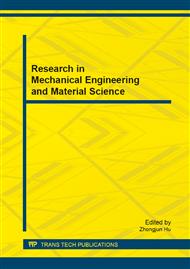p.90
p.96
p.100
p.106
p.110
p.115
p.120
p.125
p.129
Experimental Investigation on Damping Characteristic of Metal Rubber Material at Simulated Marine Environment
Abstract:
To meet the need of damping material at the marine corrosive environment, the clamped-edge disk type of metal rubber specimen is designed and its corrosion-load alternate experiment is performed, the anti-corrosive and damping characteristic of the material at the marine corrosive environment is researched. The experimental results show that the corrosive rate of 304 stainless steel metal rubber specimen at cycle-immersion corrosion-load alternate environment is the highest and its decay rate of dynamic average rigidity is also the highest, and followed by full-immersion, cycle-salt-spray and full-salt-spray environment. The damping characteristic of metal rubber specimen is relatively stable at the corrosion-load alternate experiment; the metal rubber material has anti-corrosion ability at marine environment.
Info:
Periodical:
Pages:
110-114
Citation:
Online since:
October 2013
Authors:
Price:
Сopyright:
© 2014 Trans Tech Publications Ltd. All Rights Reserved
Share:
Citation:


